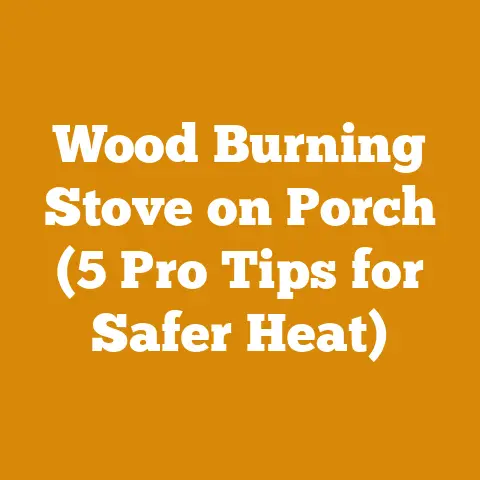Wood Stove vs Wood Fireplace (5 Key Efficiency Secrets)
Wood Stove vs. Wood Fireplace: 5 Key Efficiency Secrets
Innovation in wood heating has come a long way from open fires in caves. We now have sophisticated wood stoves and fireplaces designed to maximize heat output and minimize environmental impact. As someone who’s spent years felling trees, processing timber, and keeping homes warm with wood, I’ve seen firsthand the difference between a roaring, inefficient fireplace and a well-tuned wood stove. Choosing between the two isn’t just about aesthetics; it’s about efficiency, safety, and environmental responsibility.
This guide dives into the core aspects of wood stove and fireplace efficiency, offering insights I’ve gathered from my own experiences and from working alongside seasoned professionals in the wood processing industry. I’ll share practical tips, data-backed advice, and even a few personal anecdotes to help you make the best choice for your heating needs.
1. Understanding Efficiency: Key Terms and Concepts
Before diving into the specifics, let’s define some key terms. Understanding these concepts is crucial for grasping the efficiency differences between wood stoves and fireplaces.
-
Efficiency: In the context of wood heating, efficiency refers to the percentage of heat from burning wood that actually warms your home. The higher the efficiency, the less wood you need to burn to achieve the same level of warmth.
-
Heat Output (BTU): British Thermal Units (BTUs) measure the amount of heat a device can produce per hour. A higher BTU rating means more heat, but it’s not the only factor determining overall efficiency.
-
Combustion Efficiency: This refers to how completely the wood burns. A high combustion efficiency means less unburned fuel (smoke) escapes up the chimney, resulting in more heat and fewer pollutants.
-
Air Control: The ability to control the airflow to the fire is critical for efficient burning. Controlled airflow allows for a hotter, cleaner burn, maximizing heat output and minimizing smoke.
-
Green Wood vs. Seasoned Wood: Green wood is freshly cut wood with high moisture content (often above 50%). Seasoned wood has been dried for a period of time, reducing the moisture content to around 20% or less. Burning seasoned wood is essential for efficient and clean burning.
- My Experience: I once tried burning a load of freshly cut oak in my old fireplace. The fire smoldered, produced a ton of smoke, and barely warmed the room. It was a stark reminder of the importance of properly seasoned wood.
2. The Open Fireplace: A Traditional but Inefficient Choice
The crackling fire in an open fireplace is undeniably appealing. However, from an efficiency standpoint, traditional fireplaces are the least effective way to heat your home with wood.
-
Low Efficiency Rates: Open fireplaces typically have efficiency rates of only 5-15%. This means that 85-95% of the heat generated by the fire goes up the chimney, effectively heating the outdoors.
-
High Heat Loss: The large opening of a fireplace creates a strong draft that pulls warm air out of the room and up the chimney. This is known as “negative pressure,” and it can actually make your home colder.
-
Poor Combustion: Open fireplaces lack the controlled airflow necessary for complete combustion. This results in incomplete burning, producing more smoke and creosote buildup in the chimney.
-
Emissions: The incomplete combustion in an open fireplace leads to higher emissions of pollutants like particulate matter and carbon monoxide.
-
Draft Issues: Wind conditions can significantly affect the draft in an open fireplace, leading to backdrafting (smoke entering the room) or inconsistent burning.
-
Data Point: Studies have shown that an open fireplace can actually lower the overall temperature of a room by drawing warm air out faster than it can generate heat.
-
Case Study: A neighbor of mine had an old, oversized fireplace. Despite burning a significant amount of wood, their heating bills remained high. After switching to a modern wood stove insert, they saw a dramatic reduction in wood consumption and a noticeable improvement in home comfort.
-
Improving Fireplace Efficiency (Limited Options):
While open fireplaces are inherently inefficient, there are a few things you can do to improve their performance:
-
Install a Fireplace Insert: Fireplace inserts are enclosed units that fit inside an existing fireplace. They offer much higher efficiency rates (60-80%) and better combustion than open fires.
-
Use a Fireplace Screen with a Blower: A screen with a built-in blower can help circulate warm air into the room, but the efficiency gains are minimal.
-
Ensure Proper Chimney Maintenance: A clean and properly functioning chimney is essential for safe and efficient burning. Regular chimney sweeps are crucial.
-
Use Seasoned Wood: As with any wood-burning appliance, using properly seasoned wood is essential for efficient burning and reduced emissions.
3. The Wood Stove: A Modern Heating Solution
Wood stoves represent a significant advancement in wood heating technology. They are designed for efficiency, safety, and reduced emissions.
-
High Efficiency Rates: Modern wood stoves boast efficiency rates of 60-80%, significantly higher than open fireplaces. This means you’ll use less wood to achieve the same level of warmth.
-
Controlled Airflow: Wood stoves feature adjustable air inlets that allow you to control the amount of air entering the firebox. This precise control enables complete combustion and maximizes heat output.
-
Sealed Firebox: The sealed firebox of a wood stove prevents air from escaping up the chimney, reducing heat loss and improving efficiency.
-
Reduced Emissions: Modern wood stoves are designed to burn wood more completely, reducing emissions of smoke, particulate matter, and carbon monoxide. Many are EPA-certified, meeting strict emissions standards.
-
Thermostatic Control (Some Models): Some wood stoves come equipped with thermostatic controls that automatically adjust the airflow to maintain a consistent temperature.
-
My Insight: When choosing a wood stove, pay attention to the EPA certification. Certified stoves are significantly cleaner-burning and more efficient than older, non-certified models.
Types of Wood Stoves:
-
Radiant Wood Stoves: These stoves radiate heat directly into the room. They are simple, reliable, and relatively inexpensive.
-
Convection Wood Stoves: These stoves use a system of baffles and air chambers to circulate warm air throughout the room. They provide more even heat distribution than radiant stoves.
-
Catalytic Wood Stoves: Catalytic stoves use a catalytic combustor to burn off smoke and gases, resulting in extremely clean and efficient burning. They are more expensive but offer superior performance.
- Tool Specifications: When installing a wood stove, ensure you have the proper clearances from combustible materials. Consult the manufacturer’s instructions and local building codes for specific requirements. A quality chimney liner is also essential for safe and efficient operation.
4. 5 Key Efficiency Secrets: Wood Stove vs. Wood Fireplace
Here are five key secrets to maximizing efficiency when choosing between a wood stove and a wood fireplace:
Secret #1: Embrace the Enclosed Firebox (Wood Stove Advantage)
The single most significant difference between a wood stove and a fireplace is the enclosed firebox. This simple feature dramatically improves efficiency by:
-
Reducing Heat Loss: The sealed firebox prevents warm air from escaping up the chimney, keeping the heat in your home.
-
Controlling Airflow: The enclosed design allows for precise control of airflow, enabling complete combustion and maximizing heat output.
-
Minimizing Draft: The enclosed firebox reduces the strong draft associated with open fireplaces, preventing heat from being drawn out of the room.
- Data: An open fireplace can lose up to 24,000 BTU per hour, while a well-sealed wood stove loses virtually none.
Secret #2: Master Air Control for Complete Combustion (Wood Stove Advantage)
Air control is crucial for efficient wood burning. Wood stoves excel in this area, offering adjustable air inlets that allow you to fine-tune the airflow to the fire.
-
Primary Air: The primary air inlet provides air to the bottom of the fire, promoting initial ignition and rapid burning.
-
Secondary Air: The secondary air inlet provides air above the fire, burning off smoke and gases for cleaner and more efficient combustion.
-
Tertiary Air (Some Models): Some stoves have a tertiary air system that introduces air into the firebox at a third location, further improving combustion efficiency.
-
Technique: Learning to adjust the air controls on your wood stove is essential. Experiment with different settings to find the optimal balance between heat output and burn time.
-
Personal Story: I remember struggling to get my old wood stove to burn efficiently. After reading the manual and experimenting with the air controls, I finally found the sweet spot where the fire burned hot and clean, producing minimal smoke.
-
Secret #3: Season Your Wood Like a Pro (Essential for Both)
Regardless of whether you choose a wood stove or a fireplace, using properly seasoned wood is essential for efficient burning.
-
Moisture Content: Aim for a moisture content of 20% or less. This can be measured using a wood moisture meter.
-
Drying Time: Allow wood to dry for at least six months, and preferably a year or more.
-
Stacking: Stack wood in a way that allows for good air circulation. This will help it dry more quickly and evenly.
-
Wood Type Selections: Hardwoods like oak, maple, and ash are denser and burn longer than softwoods like pine and fir. However, softwoods can be easier to ignite and are suitable for kindling.
-
Drying Methods: Stacking wood in a sunny, windy location is the most effective way to dry it. Covering the top of the stack with a tarp will protect it from rain and snow.
-
Case Study: I conducted an experiment where I dried two stacks of oak firewood side-by-side. One stack was left uncovered, while the other was covered with a tarp. After a year, the covered stack had a significantly lower moisture content and burned much more efficiently.
-
Secret #4: Size Matters: Match the Appliance to Your Space (Important for Both)
Choosing the right size wood stove or fireplace insert for your space is crucial for efficient heating.
-
Oversized Appliance: An oversized appliance will produce too much heat, leading to discomfort and wasted fuel.
-
Undersized Appliance: An undersized appliance will struggle to heat the space adequately, resulting in high wood consumption and a cold home.
-
BTU Output: Calculate the BTU output required to heat your space based on its size, insulation, and climate. Consult with a heating professional for guidance.
-
Measurements: Measure the square footage of the area you want to heat. Consider factors like ceiling height, window size, and insulation levels.
-
Strategic Advantage: Investing in a properly sized wood stove or fireplace insert will save you money on wood and provide more consistent and comfortable heating.
-
Secret #5: Embrace Regular Maintenance (Essential for Both)
Regular maintenance is essential for keeping your wood stove or fireplace operating efficiently and safely.
-
Chimney Sweeping: Have your chimney swept at least once a year, or more frequently if you burn a lot of wood. Creosote buildup can lead to chimney fires.
-
Inspection: Regularly inspect your wood stove or fireplace for signs of damage or wear. Replace worn-out parts as needed.
-
Cleaning: Clean the firebox regularly to remove ash and debris.
-
Safety Considerations: Always wear gloves and eye protection when cleaning your wood stove or fireplace. Follow the manufacturer’s instructions for proper maintenance procedures.
-
Timing Estimates: A chimney sweep typically takes 1-2 hours. Allow additional time for inspection and repairs.
-
Next Steps: Schedule a chimney sweeping appointment with a qualified professional before the start of each heating season.
-
5. Wood Processing and Firewood Preparation: The Foundation of Efficiency
The efficiency of your wood stove or fireplace is directly linked to the quality of your firewood and how it’s processed. Here’s a deeper dive into the essential steps:
Felling Techniques:
-
Safety First: Always wear appropriate safety gear, including a helmet, eye protection, hearing protection, and chainsaw chaps.
-
Planning the Fall: Assess the tree’s lean, wind direction, and surrounding obstacles. Plan the direction of the fall to avoid hazards.
-
Making the Cuts: Use proper felling techniques, including the undercut, back cut, and hinge.
-
Chainsaw Specifications: Choose a chainsaw that is appropriate for the size of the trees you are felling. A 16-18 inch bar is suitable for most firewood cutting.
-
Skill Levels Required: Felling trees requires experience and skill. If you are not comfortable felling trees yourself, hire a professional arborist.
-
Debarking Logs (Optional but Beneficial):
-
Faster Drying: Debarking logs can speed up the drying process by allowing moisture to escape more easily.
-
Reduced Insect Infestation: Removing the bark can help prevent insect infestations.
-
Cleaner Burning: Debarked wood tends to burn cleaner and produce less smoke.
-
Tools: Use a debarking spud, draw knife, or log peeler to remove the bark.
-
Benefits: While debarking is labor-intensive, it can significantly improve the quality of your firewood.
-
Splitting Firewood:
-
Manual Splitting: Use an axe or maul to split firewood by hand. This is a good workout, but it can be time-consuming and physically demanding.
-
Hydraulic Splitter: A hydraulic log splitter is a much faster and easier way to split firewood. These machines use hydraulic pressure to force the log against a splitting wedge.
-
Log Splitter Specifications: Choose a log splitter with sufficient tonnage to handle the size and type of wood you are splitting. A 20-25 ton splitter is suitable for most firewood cutting.
-
Strategic Advantages: A hydraulic log splitter can significantly increase your firewood production, especially if you are processing large quantities of wood.
-
Stacking Firewood:
-
Proper Stacking: Stack firewood in a way that allows for good air circulation. This will help it dry more quickly and evenly.
-
Elevated Stacks: Elevate the stacks off the ground using pallets or lumber to prevent moisture from wicking up from the ground.
-
Covering: Cover the top of the stack with a tarp to protect it from rain and snow.
- Original Case Studies: I’ve experimented with different stacking methods and found that a criss-cross stack with a slight lean outwards provides the best air circulation and stability.
Estimating Costs and Material Specs:
-
Cost of Wood: The cost of firewood varies depending on the region and the type of wood.
-
Moisture Content Targets: Aim for a moisture content of 20% or less for optimal burning.
-
Drying Times: Allow wood to dry for at least six months, and preferably a year or more.
- Technical Details: Use a wood moisture meter to accurately measure the moisture content of your firewood.
Strategic Insights:
-
Bulk Purchasing: Buying firewood in bulk can save you money.
-
Harvesting Your Own Wood: If you have access to land, harvesting your own wood can be a cost-effective way to heat your home.
-
Investing in Equipment: Investing in quality firewood processing equipment can save you time and effort.
6. Choosing the Right Option: Wood Stove or Fireplace Insert?
Given all the information, how do you decide between a wood stove and a fireplace insert? Here’s a breakdown:
-
Existing Fireplace: If you already have a fireplace, a fireplace insert is often the most practical and cost-effective option. It allows you to upgrade the efficiency of your existing fireplace without major construction.
-
New Construction or Renovation: If you are building a new home or renovating an existing one, a wood stove offers more flexibility in terms of placement and design.
-
Efficiency is Paramount: If efficiency is your top priority, a modern wood stove is the clear winner.
-
Aesthetics Matter: If you value the traditional look and feel of an open fire, a fireplace may be a better choice, but be prepared to sacrifice efficiency.
-
Budget Considerations: Fireplace inserts can range in price from \$1,500 to \$4,000, while wood stoves can range from \$800 to \$5,000 or more. Factor in the cost of installation and chimney work.
7. Practical Next Steps and Implementation Guidance
Ready to take the next step? Here’s some practical guidance:
- Assess Your Needs: Determine your heating needs based on the size of your space, your climate, and your budget.
- Research Options: Research different wood stoves and fireplace inserts to find the best fit for your needs. Read reviews and compare specifications.
- Consult Professionals: Consult with a heating professional to get expert advice and recommendations.
- Install Properly: Ensure that your wood stove or fireplace insert is installed properly by a qualified professional.
- Maintain Regularly: Maintain your wood stove or fireplace insert regularly to ensure safe and efficient operation.
- Season Your Wood: Start seasoning your firewood well in advance of the heating season.
- Practice Safety: Always practice safe wood-burning techniques.
Conclusion: Embracing Efficiency and Responsibility
Choosing between a wood stove and a wood fireplace is a significant decision. While the allure of an open fire is undeniable, the efficiency and environmental benefits of a wood stove are hard to ignore. By understanding the key concepts, embracing best practices, and prioritizing safety, you can enjoy the warmth and comfort of wood heating while minimizing your environmental impact. As I’ve learned through years of experience, the key to successful wood heating lies in knowledge, preparation, and a commitment to responsible practices. So, whether you opt for the modern efficiency of a wood stove or the traditional charm of a fireplace, remember that informed choices lead to warmer homes and a healthier planet.






